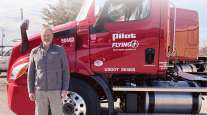Pinpointing ETAs
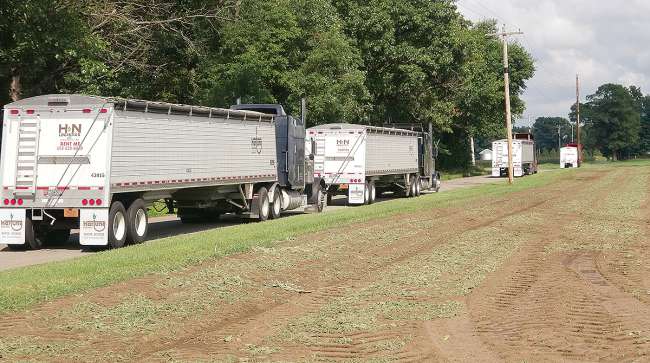
With shippers and receivers demanding tighter delivery windows, trucking companies are utilizing a range of technologies to more accurately predict when drivers will arrive at destinations.
Transportation software and fleet tracking providers are pulling together more data points, including drivers’ locations, their remaining time under hours of service, the average time spent at receivers’ locations, as well as traffic and weather conditions, to determine more precise estimates for time of arrival.
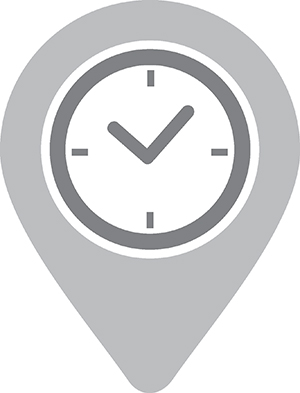
“The old way is we said we’d deliver it tomorrow. Today, customers expect it not only on the day requested but the exact time requested,” said Keith Wilson, president of Titan Freight Systems. “Because we’re an extension of the shipper, we have to be perfect or we’re going to compromise the shipper’s reputation.”
Titan, a less-than-truckload hauler based in Portland, Ore., uses software from Carrier Logistics Inc. to calculate ETAs based on the standard time to complete a route, combined with variables such as how many handling units it takes, the type of stop and specific customer needs.
“Over the course of the day, if there is a change, or they arrive or leave a stop earlier or later than anticipated, the ETA gets adjusted automatically,” said Ben Wiesen, president of CLI.
With updated ETAs, fleets are better equipped to manage such changes, which can happen frequently in LTL operations, Wiesen said.
“Each stop introduces a new margin of error in the calculation,” he said, adding that if there is a delay at a stop, a driver may consult with the dispatcher and decide to bypass a stop to minimize a ripple effect throughout the day.

Read more iTech stories:
Titan empowers its drivers to bypass a scheduled stop if they need to meet a guaranteed window at another location, even if it means the overall route becomes less efficient.
“If we don’t focus on quality [down] to the minute, there is a tremendous downstream cost both to reputation and bottom line loss of margin,” Wilson said, adding that chargebacks for late appointments can be as high as $500.
Titan said it has seen a decline in driver turnover since implementing the technology.
“The goal is to give each driver the right amount of freight to fit within their available hours and route it in the optimal delivery pattern,” Wilson said. “We used to overload drivers without knowing what they really could and couldn’t deliver.”
The level of required detail for ETAs varies from one shipper to another, but some now assign 15-minute delivery windows, said Rishi Mehra, director of web products at ALK Technologies, a provider of routing and mileage software and a unit of Trimble Transportation.
Combining weather and current and historical traffic information with drivers’ locations has played a significant role in increasing the accuracy of driver ETAs, Mehra said.
“When a tractor is in motion, we use the live motion in the initial 60 miles of the trip and then predict the remainder based on a six-month average aggregate time,” he explained.
Jay Delaney, senior director of product management for TMW Systems, another Trimble company, said some shippers want to know down to the minute when that load is going to arrive to improve yard and dock management.
TMW updates the back-office dispatch first if there is an issue that needs to be addressed, and assigns green, yellow and red indicators based on a load’s risk of running late.
“We’re providing the dispatcher with advanced notice that this one is starting to look like you may want to pay attention to it,” Delaney said. “The earlier you know you have an issue, the earlier you can remedy that issue.”
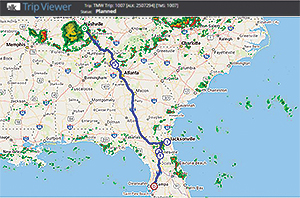
Trimble's TruETA feature combines ALK's mapping and trip management sofware with vehicle location and driver hours-of-service data to calculate up-to-date arrival times. (ALK Technologies)
The TruETA feature from Trimble Transportation, which is available to TMW users, combines information from ALK’s mapping platform as well as the current vehicle location and driver hours-of-service information captured by in-cab systems from Trimble Transportation Mobility. “We’re always constantly recalculating that ETA based on the updates of the variables,” Delaney said.
Delaney said drivers like the added insight the technology gives them.
“If a driver knows he’s been given a load he knows he can’t deliver on time and he can show you he can’t do it, that becomes very powerful to the driver,” he said.
TruETA’s driver trip planning enables drivers to view their route plan and view optimal places to stop, but still allows the driver to make changes within certain parameters.
“By allowing them to see the changes, they can see the impact to the ETA,” Delaney said. “They can play with what-if scenarios.”
H&N Logistics, a carrier based in Madison, Wis., uses TruETA to improve planning.
The system’s mobile app helps drivers better manage their time, said Justin Spafford, IT compliance specialist at H&N.
“When they take a load, they are able to take into consideration traffic, weather, HOS and how long it will take them to do a load. It will show where their breaks are going to come up, where they’ll take their 30-minute break or 10-hour break,” he said, adding that the visibility the system provides means no one has to bother a driver to find out where he or she is.
Verizon Connect, a fleet telematics provider, also captures data that fleets can use to improve planning and more precisely track ETAs.
That’s important because customers have come to expect greater transparency regarding the status of their shipments or services, said Shaz Shaukat, product manager at Verizon Connect.
Verizon Connect tracks and communicates up-to-the-minute ETAs and provides insights around fleet location, driver delays and inventory visibility, Shaukat said.
The technology provider captures data such as GPS location, vehicle diagnostics, driver status and road information such as traffic and weather-related closures and congestion.
Transportation firms can use that information to communicate and set expectations with their customers, drive dock appointment scheduling, increase collaboration, improve routing and scheduling, and provide in-transit inventory visibility, Shaukat said.
Receivers need to know not only when a truck is coming in, but also what is coming in, said Jerry Robertson, chief technology officer at Bolt System, a fleet management software provider.
“If I’m a work-in-process type manufacturer and I’m doing some type of assembly, I might be able to get 50 to 60 racks of product or I could get 75 if I just wait five more minutes for a load to come in,” he said.
Carriers also can send data ahead of time, which helps receivers schedule labor or clear a dock if there is a hot load.
“We have to do something to make sure these trucks are loaded as near capacity as possible and that they are on the road more than they are stopped and loading,” Robertson said.
Bolt System builds profiles to determine, on average, how long it takes to deliver a product based on the product type or the stop.
“If it is a retail store, we can determine generally how long it takes to get in and out and to get paperwork signed,” Robertson said. “For us to get our ETAs correct, we have to get every one of these elements correct.”
Accuracy is essential for those running a business and making decisions based on data, said Jennifer McMullan, senior sales engineer at ERoad, an electronic logging device vendor that provides vehicle location and operational data to its customers.
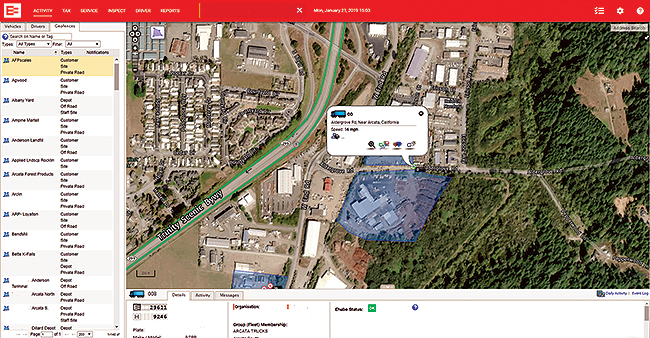
Technology vendors such as ERoad offer geofencing capabilities to notify fleets when a truck enters or leaves a pickup site or other key location. (ERoad)
“The detail of information available to carriers allows them to directly communicate load arrival times to their customers with a greater degree of confidence,” she said.
ERoad factors in drivers’ available hours in addition to the vehicle’s location.
“Dispatchers can use this information to first assign shipments, then follow the progress of the load,” McMullan said.
ERoad’s geofencing application allows a carrier to be notified if a driver has arrived at a load pickup site and when it departs that site.
“Knowing if a load has been held up at a pickup site allows the carrier to be proactive about possible delays,” McMullan said.
ERoad’s system also features a traffic map layer that allows carriers to identify bottlenecks and traffic jams along a route.
“Routing around such delays means the load will be more likely to arrive on time,” McMullan said, adding that there also is a truck-route layer that helps carriers identify roads with height, weight or hazardous materials restrictions. ³


